Children’s books are the cornerstone of many of Center for the Collaborative Classroom‘s (CCC) programs; in a way, the authors are our behind-the-scenes collaborators. We want teachers, administrators, students, and parents to be able to learn more about these wonderful authors. We are happy to present the fourth in a series of author interviews, with Rosemary Wells. Six of her books are used in our programs: McDuff and the Baby, McDuff Moves In, and Noisy Nora in Making Meaning; Bunny Cakes and Yoko’s Paper Cranes in AfterSchool KidzLit; and Shy Charles in Words in Action.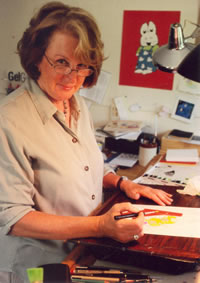
CCC: Your books are the poetry of kids’ picture books. How do you pack so much meaning (and humor!) into a handful of words and pictures? In Shy Charles, for example, you explore shyness, yes, but also individuality, judgment, acceptance, love, and stereotypes (that shyness does not equal weakness or immaturity).
Rosemary Wells: First of all, thank you. You have given me a great compliment. This “how do I do it?” question is not easy to answer. Much comes from a private belief system of how and why children thrive. It’s randomly based on my own parents’ love, their European perspective, and uproarious laughter at the vanities of human beings. It comes too of a no-nonsense, church-going upbringing in small-town America in the forties and fifties when nobody sued anybody or locked their door.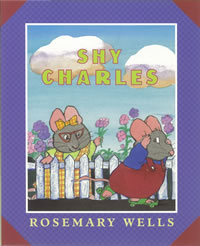 As to the few words, I had a high school English teacher, Marie E. O’Connor, a great eccentric, who taught the art of précis writing. Mondays we would be asked to write a paragraph on a given subject. Each day of the week we had to pare down our sentences by a certain number of words and keep the meaning until Friday when we had to sum up the idea in a single sentence. I was very good at this. So I learned how to express myself succinctly. Children’s books are no fun to read aloud if they are too long-winded. Mine are nutmeat books, missing no meaning or emotion but getting to the point in a few well-chosen words. I think of them as tiny plays and always let dialogue describe what would witter on and on otherwise. I also always write to the most intelligent, curious child because dumbing down is not my style. All kids listen and learn up, not down.
As to the few words, I had a high school English teacher, Marie E. O’Connor, a great eccentric, who taught the art of précis writing. Mondays we would be asked to write a paragraph on a given subject. Each day of the week we had to pare down our sentences by a certain number of words and keep the meaning until Friday when we had to sum up the idea in a single sentence. I was very good at this. So I learned how to express myself succinctly. Children’s books are no fun to read aloud if they are too long-winded. Mine are nutmeat books, missing no meaning or emotion but getting to the point in a few well-chosen words. I think of them as tiny plays and always let dialogue describe what would witter on and on otherwise. I also always write to the most intelligent, curious child because dumbing down is not my style. All kids listen and learn up, not down.
“Children’s books are no fun to read aloud if they are too long-winded. Mine are nutmeat books.”
CCC: You have an incredible ability to create characters (Max, Ruby, Nora, Yoko, Charles, I could go on) that resonate with both children and adults as genuine and sympathetic beings. Perhaps it’s your obvious affection for them and your insight into the many layers of a human being (or a bunny). What advice can you offer young writers trying to create characters that feel real?
Rosemary Wells: Try to base your characters on real-life kids whom you once were, or who come into your life or stay in your memory. My stories are “non-fiction.” Max and Ruby were my own children. Yoko was a classmate of my daughter’s. Charles was a third-grade classmate of mine. Nora was my grade school best friend, Virginia O’Malley, who was a middle child.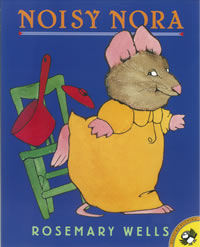 If you write for young people, avoid the cause book. Kids smell adult agendas a mile away. In short, try not to make death of a loved one or peanut allergies or any other “issue” the subject of a book because it tends to take over and become the character. Let your actual character lead your idea and watch where it goes. Never use two adjectives where one will do! Write the unexpected. One day in California I stopped at an old railway car-an antique store for large furniture and huge amphorae etc. I peered into a beautiful armoire. On the inside of its walls were pasted an entire correspondence from a grandfather to his granddaughter. I was entranced with the beautiful handwriting and the devotion that spilled onto the lined pages from a long ago notebook. I read the letters through, although it took more than two hours. From this accidental experience sprang a story, whole, with fully formed characters, a beginning, middle, and end, called “Following Grandfather.” I wrote the whole thing in the next twelve hours in my hotel. It will be published by Candlewick next year.
If you write for young people, avoid the cause book. Kids smell adult agendas a mile away. In short, try not to make death of a loved one or peanut allergies or any other “issue” the subject of a book because it tends to take over and become the character. Let your actual character lead your idea and watch where it goes. Never use two adjectives where one will do! Write the unexpected. One day in California I stopped at an old railway car-an antique store for large furniture and huge amphorae etc. I peered into a beautiful armoire. On the inside of its walls were pasted an entire correspondence from a grandfather to his granddaughter. I was entranced with the beautiful handwriting and the devotion that spilled onto the lined pages from a long ago notebook. I read the letters through, although it took more than two hours. From this accidental experience sprang a story, whole, with fully formed characters, a beginning, middle, and end, called “Following Grandfather.” I wrote the whole thing in the next twelve hours in my hotel. It will be published by Candlewick next year.
CCC: Your picture books present a benevolent world, with a comforting lack of anxiety, regardless of its perils (e.g., the bullies in Hazel’s Amazing Mother or the dogcatcher in McDuff Moves In). You don’t sugarcoat problems, yet life feels balanced. Do you strive for this or do the stories just turn out that way?
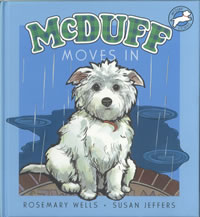 Rosemary Wells: In my American childhood, life was never sugar coated. We had bullies, we had racial and gender discrimination, we had candy cigarettes, and we had more car and bike accidents due to the absence of safety devices. Nonetheless, despite all of this, and the Soviets and their bombs, millions of American kids felt amazingly content with their world and safe in it. There were no rules everywhere and warnings all over everything. That’s because people took responsibility for their own stuff and didn’t point the finger of blame. We have sown fear into the hearts of our kids. Stranger danger looms much worse now than it did then. The internet and our weapon besotted culture are much to blame-the information explosion scatters violent and heavily sexual material into our children’s lives through many channels. So life was balanced then. It is not balanced now. Children thrive in a balanced world. I know that as one ages the world seems newly challenging and often inscrutable, but the whole tenor of our culture has changed into something that I don’t believe is doing American children much good.
Rosemary Wells: In my American childhood, life was never sugar coated. We had bullies, we had racial and gender discrimination, we had candy cigarettes, and we had more car and bike accidents due to the absence of safety devices. Nonetheless, despite all of this, and the Soviets and their bombs, millions of American kids felt amazingly content with their world and safe in it. There were no rules everywhere and warnings all over everything. That’s because people took responsibility for their own stuff and didn’t point the finger of blame. We have sown fear into the hearts of our kids. Stranger danger looms much worse now than it did then. The internet and our weapon besotted culture are much to blame-the information explosion scatters violent and heavily sexual material into our children’s lives through many channels. So life was balanced then. It is not balanced now. Children thrive in a balanced world. I know that as one ages the world seems newly challenging and often inscrutable, but the whole tenor of our culture has changed into something that I don’t believe is doing American children much good.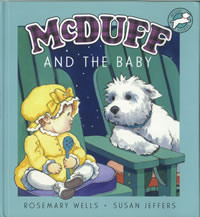
CCC: You’ve expressed gratitude for your parents’ support and deep understanding of art. How has their influence affected your life’s work? Were they able to witness your success as a children’s book author?
Rosemary Wells: My parents died in the 1980s. They saw my early success and they never doubted my purpose for a minute.
CCC: You’ve written over 120 books, raised your own children, and observed a lot in your life. How has your perception of “the secret world of children” evolved over time and how has this evolution influenced your work?
Rosemary Wells: I am afraid the secret world may not easily flourish in the age of direct-to-child marketing and excessive adult attention in general. The secret world of children needs privacy and quiet time to flourish; this world might be one invented near a stream in the woods by a child who brings small dolls and creates a house and boat and imaginary life for those dolls with no grownup ever looking on, organizing it, or saying “how cute and creative!” It might be a game of King of the Mountain organized only by neighborhood kids themselves with no adult supervision. It might be a tree house built by someone ten years old who shares it with a best friend and no adult offers advice or takes pictures with a smartphone or ever cares about it!
“The secret world of children needs privacy and quiet time to flourish.”
I write wholesome books that are many-layered and gently real. I don’t write about vampires or dystopian systems just around the next bend, that’s for sure. The secret world is all I know and so I write to it, for it and about it, whether it’s a dying world or not. I hope not.
CCC: In reference to the ideal teacher on whom Miss Cribbage and Mrs. Jenkins (teachers in My Kindergarten and Yoko) were based, you said “She is not the voice of testing, she is not the voice of SAT prep, she is the voice of ultimate patience and wisdom…I was lucky enough in New Jersey in the 1940s to have a lot of these teachers. They were smart, and patient, and kind and mostly they were stable influences.” Could you tell a story about one of those great teachers?
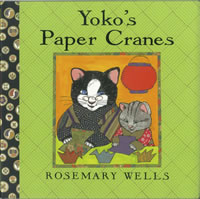 Rosemary Wells: My first-grade teacher, Pat Blair, realized that I was drowning in boredom, listening to each member of the class read aloud Dick and Jane. I read the whole Dick and Jane book on the first day of school. Miss Blair recognized the damage boredom could cause a child. Rote teaching turns off more kids than it educates. All classrooms have unevenly skilled kids. Those who are ahead or behind the “norm” should be appropriately encouraged. So Pat Blair let me and other children who loved reading at home read our own books quietly in the classroom while others learned to read. Teachers who recognize differences in children and honor them are very special. I also had a history teacher in high school, Bernet Henyon. He taught me a love of history that has stayed with me all my life. Then there was Marie E. O’Connor, the précis specialist. Public school teachers didn’t ever teach to tests. There was no SAT prep; teachers had their own agendas and we were better educated and smarter for it.
Rosemary Wells: My first-grade teacher, Pat Blair, realized that I was drowning in boredom, listening to each member of the class read aloud Dick and Jane. I read the whole Dick and Jane book on the first day of school. Miss Blair recognized the damage boredom could cause a child. Rote teaching turns off more kids than it educates. All classrooms have unevenly skilled kids. Those who are ahead or behind the “norm” should be appropriately encouraged. So Pat Blair let me and other children who loved reading at home read our own books quietly in the classroom while others learned to read. Teachers who recognize differences in children and honor them are very special. I also had a history teacher in high school, Bernet Henyon. He taught me a love of history that has stayed with me all my life. Then there was Marie E. O’Connor, the précis specialist. Public school teachers didn’t ever teach to tests. There was no SAT prep; teachers had their own agendas and we were better educated and smarter for it.
CCC: What do you think about the role of technology in children’s lives, particularly school lives? Are there ways you think digital content can enhance the classroom? Ways it detracts?
Rosemary Wells: Technology, wonderful as it can be, can also destroy the teacher-student relationship. When a child’s attention is on a screen, not on the teacher’s face and voice, the teacher loses authority and the student loses human contact. Kids have enough screens day and night. Teachers cannot compete with screens. Kids also email like crazy and play games in class if they are online. If it were up to me, I would cut laptop use out of every classroom in America. I propose computer use only for research and with big fat V-chips! By law! By Congress. I would allow only Jitterbug phones-these are the old folks’ mobile phones which would work fine to call your mom, or any five other numbers, when you are late for the bus but allow no texting or internet access or other nonsense that our kids are clearly too young to handle. Cell phone use only outside the school and over the age of “responsibility” whatever that may be. Perhaps 18. By law! By Congress! Of course, there is a plus side to everything. Kids now have huge access to the world around them through search engines. The answer to every question can be had in a few seconds time on Google. Provided the child is not able to stumble into inappropriate information, wonderful movies and history clips are there at the touch of a finger. Kids need limits on their screen time so they are not just drifting online for hours, playing games and/or in dicey places! This requires very awake and aware parents. Not a specialty in all households!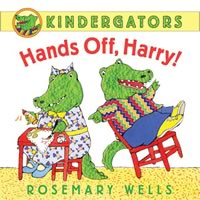
CCC: You recently teamed up with HarperCollins to launch “Kindergators,” a new series of books that deal with behavioral issues in the classroom. (I read that your approach to these issues was inspired by Responsive Classroom-an organization whose work we greatly admire.) Do you think many kids are coming to school less socialized than they were in the past?
Rosemary Wells: According to the teachers I talk to, there is a sea change in America. Enormous numbers of kids come to school unsocialized and unprepared to learn, or pay attention. Our teachers get stuck with this problem. “Kindergators” is a series of ten books, meant to be a behavior reference for teachers and parents and kids. Each character gets a showpiece book of his or her own. Each is devoted to the problem behavior and how this can be made better by the kids all-around affected by the problem, whether it’s hitting, melting down, making messes, not telling the truth, etc. Privately I believe public schools should be first about our children learning and being good citizens. Children who are serially disruptive and who absorb much more than one child’s share of a teacher’s precious time need to be accepted into the system only when they are ready to be good classmates. Participation in their kid’s education needs to be a legal parents’ requirement. That would get parents’ attention in a hurry. It would stop our schools from being vast babysitting institutes and give disadvantaged kids a real chance to get ahead. In the meantime, Responsive Classroom is one answer to this. It gives the kids a system of peer group standards to which almost everyone adheres enthusiastically. Those are lucky kids and good schools. “Kindergators” is based on the Responsive Classroom approach.
CCC: Looking to the future, what do you think will be important for teachers and children’s book authors to keep in mind about their students and readers?
Rosemary Wells: Just keep the kids reading for the love and pleasure of it, not for tests, not for accelerated reading lists.
- Don’t let them fall behind in summer. Require summer reading for all grades, at home, and with the parents. Prove you’ve read the books or you get held back.
- Teach Civics. Kids need to know how our government is supposed to work.
- Teach much more history!
Remembering always, in books is freedom, escape, the building of a healthy mind, critical thinking, and above all the making of good citizens. The Democracy we treasure is built on a population of educated, free-thinking, imaginative people.
“…In books is freedom, escape, the building of a healthy mind, critical thinking, and above all the making of good citizens.”
CCC: In reference to children’s books you said, “This is the one form of literature that takes 500 readings aloud without flinching.” In Making Meaning lessons, rereading-not 500 times, but a few-is an important step in the process of learning how to comprehend. Adults rarely reread books for themselves. Do you find rereading valuable? If so, what books have you reread and why?
Rosemary Wells: I reread a lot of history, and then there are favorites. My all-time favorite is Jack Finney’s Time and Again—utterly believable magic.
CCC: In CCC classrooms students listen carefully to each other, feel safe enough to make mistakes, and are taught to voice their own opinions in a respectful way. Most of the time, children’s literature is the linchpin in the process. Providing students the opportunity to reflect on the characters’ as well as their own and others’ lives, share insights, and back them up with concrete examples. Could you talk about the use of literature in the classroom, how it was used in the classrooms of your childhood and in classrooms these days?
Rosemary Wells: I think it is so important to bring children’s literature into all our kids’ lives, but especially those children who may not get it at home. That’s what CCC does so well. Children’s literature provides kids with real humor and real-life characters which they can’t ever find in textbooks. That is your mission and I applaud it enthusiastically. I would caution against asking too many serious adult questions which may interfere with the individual student’s personal interpretation. As you know, there are no right or wrong answers in music, art, and literature. Keep in mind that a class of 30 kids can see a video or TV show and they will all give the same answers to questions and have the same pre-imagined-for-them pictures in their heads. The same 30 kids will have wildly different impressions of a book because they make it up in their own heads. This is to be preserved and honored above all. It’s why the book must never take second place to any other kind of media or learning.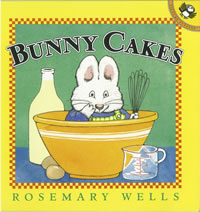 We didn’t have so many books back when I was young. Those ones we did have we read again and again, but at home. Hyper publishing is part of our time now. Kids who have no other outlet or connection to the world outside their personal experience can ingest truckloads of empathy, aspiration, and imagination from the fabulous books available today. That means our legislatures need to support school and public libraries instead of closing them. My kids had many more books than I did and my grandchildren have many more yet.
We didn’t have so many books back when I was young. Those ones we did have we read again and again, but at home. Hyper publishing is part of our time now. Kids who have no other outlet or connection to the world outside their personal experience can ingest truckloads of empathy, aspiration, and imagination from the fabulous books available today. That means our legislatures need to support school and public libraries instead of closing them. My kids had many more books than I did and my grandchildren have many more yet.
CCC: What children’s books do you most enjoy reading to your grandkids and why?
Rosemary Wells: There are so many. I’d have to give a list of 20 and leave out 20 other favorites. We just finished the Dinosaurs of Waterhouse Hawkins and are reading Ann Martin’s Doll People to the twins who are almost seven. They love Ramona and Ivy and Bean. The babies (18 months) are into Maisie, Dr. Seuss, and those endless but wonderful DK photo books of first 100 words and pictures. A little Max and Ruby too!
CCC: You’ve mentioned elsewhere that your teenage years were tough. What advice do you have for kids who are feeling alone or out of the mainstream? What helped you through the most challenging times?
Rosemary Wells: I could write a novel in answer to that question. But my teenage years were not so hard compared to what some teenagers experience now. I lived before the age of Heathers and corporate takeover of the peer group ruling class. All I can say is that whatever is a problem when you are young and agile will pass and when you get to college or work you gain a huge new peer group who doesn’t know anything about you and you can start all over. Find your pathway out of boredom or pain, worry and trouble in books. It’s really hard to feel sorry for yourself for not being invited to the senior prom after you’ve read The Diary of Anne Frank! Books are your best friends.
CCC: What is something your young readers might be very surprised to know about you?
Rosemary Wells: If I had not fallen into the career as a writer/illustrator I would have wanted to work for the FBI. Failing that, when I was young I wanted to be the first major league female ballplayer. I was a very good pitcher and still am!
